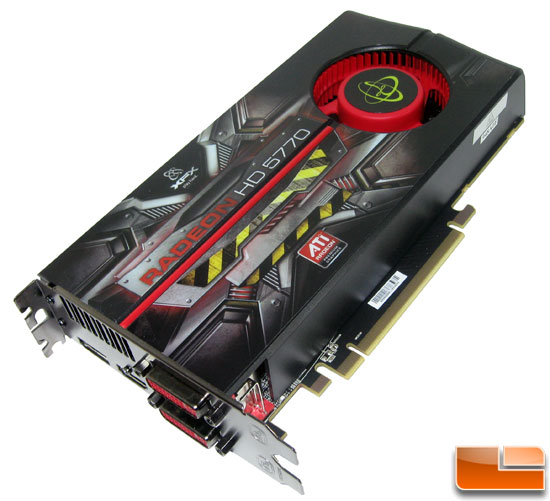XFX Radeon HD 5770 1GB GDDR5 Video Card Review
XFX Radeon HD 5770
With XFX focusing only on ATI’s 5xxx series, the mid-range market (which is the majority of gamers) became incredibly competitive, as well as the high end. Looking at any eTailer, such as Newegg or the like, throughout the performance spectrum XFX cards are at least tied for being the lowest price of any given model, making them attractive to say the least. What more could you want? The XFX Radeon HD 5xxx video card series is cheaper than the competition and has spectacular support as well.
When I headed over to XFXForce.com, I saw that XFX offers a staggering eleven different Radeon HD 5770 models all with 1GB of GDDR5 memory. Looking closer at the specs for each card, three models were factory overclocked, and one reference clcok is only available in Korea. That makes a total seven different reference clock HD 5770’s with varying heat sinks and the card we have today is not even on that list!

Today we have the XFX Radeon HD 5770 1GB model ZNFR. This is another reference spec and design card, and with 1360 GFLOPS of computing power it still has plenty of power under the hood- matching the Radeon HD 4890 of yesterday plus the DirectX 11 tessellation part. Below is a specs comparison of all the mid-range DX11 cards available. I would include NVIDIA DX11 cards, but there are none that fall into the sub-$250 range or close to it. Before we dive right into the specs, let’s take a look at the quick feature set of this card.
XFX HD-577A-ZNFR GPU Features:
- 1 GB GDDR5 memory
- ATI Eyefinity technology with support for up to 3 displays
- ATI Stream technology
- Designed for DirectCompute 11 and OpenCL
- Accelerated Video Transcoding (AVT)
- Compliant with DirectX 11 and earlier revisions
- Supports OpenGL 3.1
- Dual-mode ATI CrossfireX technology support for highly scalable performance
- ATI Avivo HD video and display technology
- Dynamic power management with ATI PowerPlay technology
- DualLink-DVI, DualLink-DVI, DisplayPort, HDMI video out connectors
- PCI Express 2.1 support
Specifications
| Radeon HD 5670 | Radeon HD 5750 | Radeon HD 5770 | Radeon HD 5830 | |
| Shader Units | 400 | 720 | 800 | 1120 |
| GPU Core | Redwood XT | Juniper PRO | Juniper XT | Cypress LE |
| Die Size | 110mm | 170mm | 170mm | 334mm |
| Transistors | 627M | 1040M | 1040M | 2154M |
| Mem Size | 512MB/1GB | 512MB/1GB | 512MB/1GB | 1GB |
| Memory Bus Width | 128-Bit | 128-Bit | 128-Bit | 256-Bit |
| Memory Bandwidth | 64GB/s | 73.6GB/s | 76.8GB/s | 128GB/s |
| Core Clock | 775 MHz | 700 MHz | 850 MHz | 800 MHz |
| Memory Clock | 1000 MHz | 1150 MHz | 1200 MHz | 1000 MHz |
| Price | $89.99 | $129.99 | $164.99 | $239.99 |
Specifications-wise, the Radeon HD 5750 is very similar to the Radeon HD 5770, just at lower clocks with a few unified shaders disabled. So we’ll mainly be looking at a comparison of whether the $35 price premium is worth it, and how the Radeon HD 5770 fares against NVIDIA’s GT200 line.

Comments are closed.